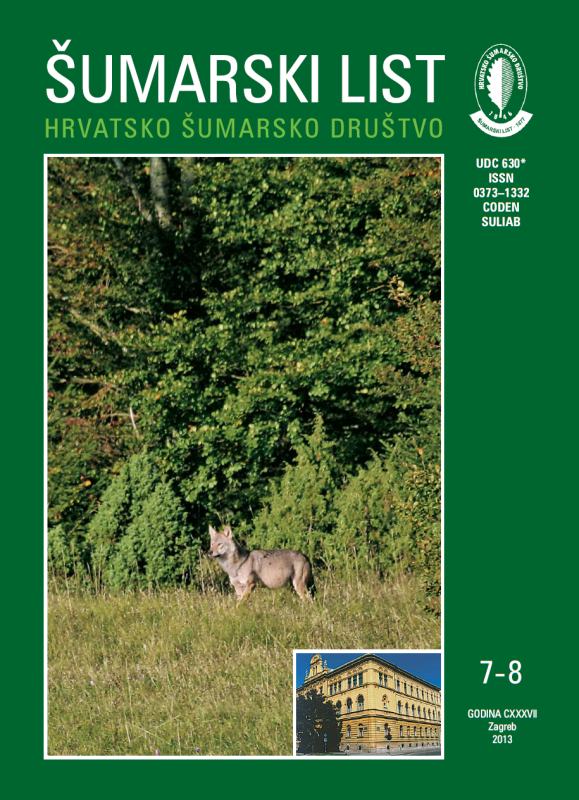
broj: 7-8/2013
pdf (5,06 MB) |
|
||||||||||||||
| RIJEČ UREDNIŠTVA | ||
| Uredništvo | ||
| DO FORESTRY PRACTICES DISREGARD THE PRINCIPLES OF SUSTAINABLE FOREST MANAGEMENT? pdf HR EN | 365 | |
| IZVORNI ZNANSTVENI ČLANCI | ||
| Krunoslav Teslak, Jura Čavlović, Mario Božić, Karlo Beljan | UDK 630*228 + 653 (001) | |
| PEDUNCULATE OAK (Quercus robur L.) TREES QUALITATIVE STRUCTURE AS A CRITERIA OF THE STAND REGENERATION PLANNING pdf HR EN | 367 | |
| Miroslav Balanda, Ján Pittner, Milan Saniga, Ján Jaďuď, Lucia Danková, Marián Ďuriš | UDK 630*815 + 612 * (Picea abies L. Karst) (001) | |
| STAND DYNAMICS OF THE SUBALPINE SPRUCE (Picea abies L. Karst) FOREST – A DISTURBANCE DRIVEN DEVELOPMENT pdf HR EN | 379 | |
| Dimitrios N. Avtzis and Dinka Matošević | UDK 630*453 (001) | |
| TAKING EUROPE BY STORM: A FIRST INSIGHT IN THE INTRODUCTION AND EXPANSION OF Dryocosmus kuriphilus IN CENTRAL EUROPE BY mtDNA pdf HR EN | 387 | |
| Summary: The chestnut gall wasp, Dryocosmus kuriphilus, poses one of the latest additions to the long list of exotic pests that invaded Europe. After its introduction in Italy, chestnut gall wasp expanded rapidly in Europe in a very short period of time. Analysis of a polymorphic mtDNA locus from nine European populations verified the Chinese origin of this invasion. Moreover, the results revealed traces of a severe bottleneck during the phase of introduction that reduced considerably the genetic diversity. It was also shown that the rapid and successful post-introductory expansion was accomplished by a single mtDNA haplotype that has spread in three European countries. The paradox of successful establishment despite the absence of genetic diversity could be attributed to the synergistic effect of several agents. Uniparental propagation and general-purpose genotypes, lack of natural enemies and human-mediated transport seem to have facilitated the invasion and subsequent expansion of D. kuriphilus in Europe. Key words: chestnut gall wasp; invasive pest; post-introductory expansion; population bottleneck | ||
| Oto Nakládal, Petr ŠENFELD, Milivoj FRANJEVIĆ, Hana UhlÍková | UDK 630*453 (001) | |
| COMPARISON OF ALL SEASON AND STANDARD TYPE OF ECOLURE® DISPENSER EFFICACY IN TRAP CATCHES OF EUROPAEAN SPRUCE BARK BEETLE (Ips typographus (L.)) pdf HR EN | 395 | |
| Petra GROŠELJ, Lidija ZADNIK STIRN | UDK 630*629 (001) | |
| BETWEEN COMPROMISE AND CONSENSUS IN GROUP DECISIONS IN FOREST MANAGEMENT pdf HR EN | 403 | |
| STRUČNI ČLANCI | ||
| Alojzije Frković | UDK 630*156 | |
| HUNTING AND HUNTING OPPORTUNITIES IN THE DISTRICT OF SENJ IN THE PERIOD FROM THE 19th TO THE BEGINNING OF THE 20th CENTURY pdf HR EN | 411 | |
| KORICE | ||
| Boris Hrašovec | ||
| Elm bark beetles – important and essential biological factor in Dutch elm disease spread PDF | 440 | |


